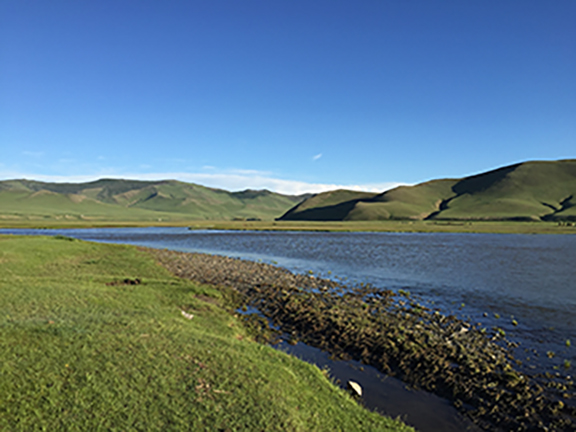
10-20 in. of rain annually
Mongolian Steppe

Base of Turks, Uighurs and Mongols
Born Temujin
Warfare
Alliances
Marriage politics
Multiple wives in steppe society vs. wife-concubines in China
Khuriltai (assembly), 1206
Capital at Karakorum

Why are we standing next to evidence of state-forced Chinese migrants at Karakorum?
Khan |
Southward |
Westward |
| Chinggis Khan, r. 1206-1227 | Xi Xia (Tangut), 1210 Jin (Jurchen) Beijing, 1211-5 Xi Xia (Tangut), Chinggis Khan killed, 1227 |
Khwarazm Shah: Bukhara & Samarqand, 1219-1221 |
| Ögödei, r. 1229-41 | Jin (Jurchen), Kaifeng, 1234 | Russia & Ukraine, 1237-40 |
| Güyük, r. 1246-48 | ||
| Mongke, r. 1251-1259 | Iran & Iraq, 1258-60 |

According to Skaff, why does modern Mongolian nationalism give too much credit to Chinggis Khan while ignoring the contributions of his son, Ögödei, and grandson, Mongke?
Capture of Jin capital, Zhongdu, 1215
Reorganization of tribes
Units of 10, 100, 1000, and 10,000 (tumen)
Turks: Cavalry
China, Russia, and Iran: infantry, siege weapons
Hessl, Amy, et al. “Tree Rings, Climate, and People in Central Asia,” 2013.
Extremely dry, 1175-1190
Extremely wet, 1211-1226
Compare with Hansen, p. 311
Ecological impact
1 tumen=10,000 men, 150,000 horses, 1,500,000 sheep
Tax policies
Irregular taxation until ca. 1250
Reforms of Mongke (r. 1251-9)
Grandson of Genghis Khan, b. 1215
Founded Yuan dynasty
Conquered S. Song, 1279
Insufficient grasslands
Terrain unsuited to cavalry warfare
Waterways
Forests
Mountains
Chinese Infantry
Navy
Siege warfare
Mongols
Semu “People of Various Categories”
Khitans, Uyghurs and others
Northern Chinese
Southern Chinese
Crop exchanges
Long distance trade
Technological exchanges
China
Gunpowder 6th c.
Fire arrows, 9th c.
Bombs 11th c.
Cannon 13th c.
Spread of gunpowder and firearms
Mongols carried technology to Middle East/Russia